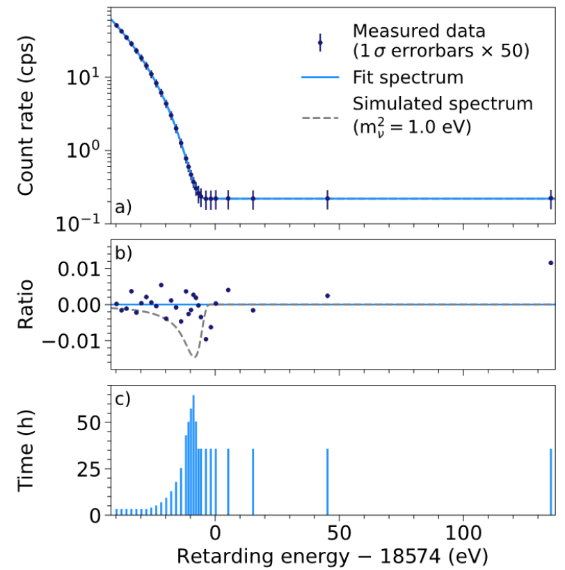The KATRIN (KArlsruhe TRItium Neutrino Experiment) located at the Karlsruhe Institute of Technology (KIT) has just crossed a symbolic threshold. In a paper published in the prestigious journal Nature Physics, the collaboration reveals a new upper limit of 0.8 eV/c^2 for the mass of neutrinos. This result is of fundamental interest for both particle physics and cosmology.
Neutrinos are the most abundant massive particles in the universe. They are the remnants of the Big Bang or of the burning of the core of stars, and are also produced in certain radioactive decays, such as that of tritium, an unstable isotope of hydrogen.
On a cosmological scale, these featherweights of the universe play a crucial role in the distribution of galaxies. In the realm of the infinitely small, the origin of the mass of neutrinos is still unexplained by theory and could be a key element in unveiling new physics beyond the Standard Model.
The determination of the tiny mass of neutrinos has therefore been a major concern in particle physics, astrophysics and cosmology for decades.
This is the challenge taken up by the international KATRIN experiment, located at the Karlsruhe Institute of Technology (KIT), with partners from six countries, including the CEA. KATRIN uses the beta decay of tritium to determine the mass of the neutrino via the energy distribution of the electrons released during the decay process. This precision measurement requires a considerable technological effort: the 70 m long experiment houses the world's most intense tritium source and a giant spectrometer to measure the energy of the decaying electrons with unprecedented accuracy (see Figure A). Following the first results published in 2019, the quality of the data has been continuously improved: 'KATRIN is an experiment that meets the highest technological requirements and now works like a precision clock', says Guido Drexlin from KIT, co-spokesperson of the collaboration. Christian Weinheimer (University of Münster), the other co-spokesperson, adds that "the increase in the signal sought and the reduction in background noise were decisive for this new result.

Figure B: a) energy distribution of tritium decay electrons measured by KATRIN - error bars are amplified by a factor of 50 b) residuals normalised for best fit to the data, for a zero mass neutrino in blue and for a 1eV/c2 mass neutrino in dashed grey c) distribution of measurement time for each energy analysed. Most of the time is used to probe the spectrum around 1565 eV, the region where neutrino mass-induced distortion is expected. © KATRIN collaboration
The in-depth analysis of the data required the hard work of the international analysis team coordinated by Magnus Schlösser (KIT) and Susanne Mertens (MPP and TU Munich). Every instrumental effect, no matter how small, had to be studied in detail. "Thanks to this laborious and complex methodology, we were able to exclude any systematic bias in our result. We are particularly proud of our analysis team, which took on this enormous challenge with great commitment," say the two coordinators of the analysis.
The results just published in Nature Physics (December 2021) are unequivocal: so far, no trace of a neutrino mass could be detected in the collected data (see Figure B). Therefore, a new upper limit on the neutrino mass of 0.8 eV is established. "The particle physics community is excited that the 1-eV barrier has been broken by KATRIN," comments neutrino expert John Wilkerson (University of North Carolina). This is the first time ever that a direct experiment has gone below the electronvolt threshold (see figure C), a range that is essential both for particle physics and for understanding the structure of our cosmos.
CEA/IRFU plays a major role in the analysis and interpretation of the data. The global architecture of the analysis, including many steps to check the robustness of the results, was designed and implemented by Thierry Lasserre (IRFU/DPHP), previously coordinator of the analysis. After its successful implementation for the first measurement campaign in 2019, the same analysis procedure is applied again, leading to these new results published in Nature Physics. In another development, CEA/IRFU performed one of the three independent analyses that established this new limit of 0.8 eV/c2, a world first in neutrino physics.
The co-spokespersons and coordinators of the KATRIN analysis are very optimistic about the future: "Neutrino mass measurements will continue until the end of 2024. In order to realise the full potential of this unique experiment, we are not only steadily increasing the amount of data, but also implementing improvements to further mitigate the background noise. The development of a new detection system (TRISTAN) plays a specific role in this respect, allowing KATRIN, from 2025 onwards, to search for 'sterile' neutrinos with masses in the keV range, a candidate for the mysterious dark matter of the cosmos”.
• The ultimate constituents of matter › Neutrino Physics
• Institute of Research into the Fundamental Laws of the Universe • The Particle Physics Division
